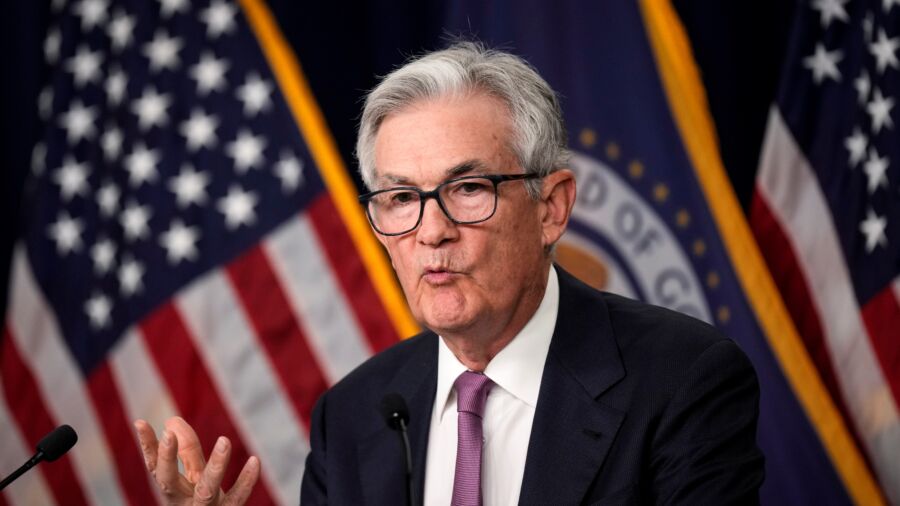Federal Reserve Chair Jerome Powell told a European Central Bank forum that the U.S. economy should expect more monetary policy restrictions to come and that inflation won’t return to its 2 percent target for a couple of more years.
During a panel discussion with his central bank counterparts, Powell said that policy hasn’t been restrictive for a long time. When the institution started its quantitative tightening campaign in March, real (inflation-adjusted) interest rates were negative and only recently touched positive territory.
“We’ve now moved up to where we actually are in restrictive territory, but we haven’t been there very long,” Powell said at the event in Sintra, Portugal, on June 28. “We believe there’s more restriction coming.”
Because labor market conditions remain tight and economic growth has been far more resilient than anticipated, Powell said he thinks policy “may not be restrictive enough, and it has not been restrictive for long enough.”
The U.S. central bank chief reiterated the Survey of Economic Projections (SEP) data showing two more rate hikes this year, with the median policy rate seen rising to 5.61 percent.
But while the Federal Open Market Committee (FOMC) left the benchmark Fed funds rate unchanged at a range of 5 to 5.25 percent following 10 straight increases, Powell didn’t take rate hikes at consecutive meetings off the table. However, later in the conversation, the Fed chair asserted that it would be “appropriate” to slow the pace of rate hikes.
The key inflation gauge for Powell and Fed policymakers is non-housing services inflation, which consists of travel, food, financial, health care, and hotel services. In May, the annual services inflation rate slowed for the third consecutive month, coming in at 6.3 percent.

According to Powell, this is where the central bank needs to see more progress, citing elevated labor costs. At the same time, signs of softening in the U.S. labor market show up in the data.
“We need to see a better alignment of supply and demand in the labor market and see some more softening and labor market conditions so that inflationary pressures in that sector can also begin to subside,” he stated.
The U.S. economy added 339,000 jobs in May, the unemployment rate advanced to 3.7 percent, and annualized average hourly earnings slowed to 4.3 percent. The June non-farm payrolls report, which will be released on July 7, is forecast to show 200,000 new positions and an unchanged jobless rate of 3.7 percent.
Overall, Powell said he doesn’t expect core inflation, which strips the volatile food and energy components, to return to the Fed’s 2 percent target until 2025.
“It’s going to take some time. Inflation has proven to be more persistent than we expected and not less,” Powell said. “Of course, if that day comes when that turns around, that’ll be great. But we don’t expect that.”
On the topic of the balance sheet, Powell agreed that quantitative tightening is working as the Fed expected. The underlying pace of trimming the roughly $8.4 trillion balance sheet is $1 trillion per year.
“Reserves appear to be quite ample. So it has a ways to go,” Powell said, adding that there isn’t anything to speed up or slow down the balance sheet reduction efforts.
Bank Stress
Powell repeated that the U.S. banking system is sound, stable, highly liquid, and well-capitalized. However, he revealed that bank stress experienced earlier this year factored into the thinking at this month’s meeting.
“There’s a fair amount of research showing that when something like that happens, bank credit availability and credit can move down a little bit with a bit of a lag,” he said. “So we’re watching carefully to see whether that does appear.”
One area of concern is the sector’s exposure to commercial real estate, an industry that has fallen on hard times amid higher interest rates and the work-from-home shift. The chief worry, Powell said, is banks with a high commercial real estate concentration, mostly seen in the small banks with less than $100 billion in assets. Right now, Fed supervisors are talking to financial institutions about how they can manage this exposure.
The 2023 bank stress test results will be released on June 28. This year’s stress test, designed before the banking turmoil in March, examines various scenarios: a 6.5 percent unemployment rate, a sharp 38 percent decline in home prices, a 40 percent collapse in commercial real estate prices, and an “exploratory market shock.”
It’s widely expected that all 23 banks will pass the stress test.
Recession Talk
According to the FOMC minutes from the May meeting, Fed economists anticipate a mild recession later this year, but there is still plenty of uncertainty, Powell noted at the June 28 event.
“There’s a significant possibility that there will be a downturn,” Powell said. “It to me is not the most likely case, but it’s certainly possible, and of course, many forecasters do predict that.”
The Atlanta Fed GDPNow model estimate shows second-quarter GDP growth coming in at 1.8 percent.
The Fed’s SEP revised the real GDP prediction for 2023 from 0.4 percent in March to 1 percent. Growth was revised downward from 1.2 percent to 1.1 percent in 2024. In 2025, the annual GDP growth rate is forecast to expand by 1.8 percent, down from 1.9 percent in the March SEP data.
During his semi-annual monetary policy report to Congress last week, Powell warned that the U.S. economy would witness below-trend growth for a while.
From The Epoch Times


